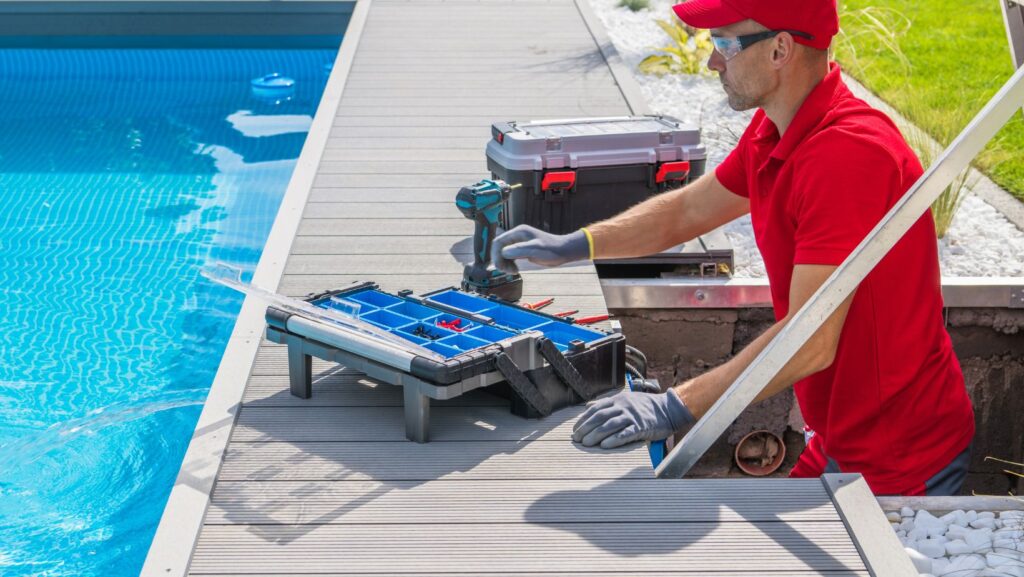Many pool owners in Austin wonder why their pool water still looks cloudy even after a thorough cleaning. The answer often comes from more than just visible dirt or leaves. Cloudy pool water is usually due to chemical imbalances, filter issues, or poor water circulation, even if the surface looks clean.
People often try to fix cloudy water by cleaning debris and scrubbing surfaces, but common problems like bad filtration and unbalanced chlorine can keep water looking murky. Sometimes, the weather in Austin or heavy swimming use can make these problems worse. For those having trouble with keeping their pools clear, finding Austin pool repair services can help with ongoing water problems and get pools looking great again.
Common Reasons Pool Water Remains Cloudy After Cleaning
Pool water in Austin can stay cloudy even after a cleaning for several reasons. Issues with filtration, water chemistry, or lingering debris all play a role.
Inadequate Filtration System
A pool filtration system that is not working well can leave tiny particles floating in the water. If filters are dirty, clogged, or old, they do not trap debris. This lets fine dirt, pollen, and other particles stay in the pool.
Even after brushing and vacuuming, cloudy water can stick around if the filter is not running long enough each day. Most pool filters need regular cleaning or backwashing. If there are leaks or the pump is weak, water does not flow through the filter as it should.
A pool in Austin with a malfunctioning filter will keep its cloudy look until the problem is solved. Regular filter maintenance keeps particles from building up and causing problems.
Signs of a filtration problem:
- Water feels gritty or looks dull
- The filter pressure is too high or too low
- Visible dirt in the return jets
Improper Chemical Balancing
Even if a pool looks clean, incorrect chemical levels can make water appear hazy. If pH is too high or too low, chlorine loses its effect. Low free chlorine lets algae and bacteria start to grow.
High calcium hardness or total alkalinity can also make water dull and cloudy. Adjusting chemicals to the right range is important following a cleaning. Local tap water may contain minerals, and this is common in Austin.

Regularly using a test kit helps keep levels in check. When they are in the right range, the sanitizer works well, and the water stays clear.
Key chemical levels to check:
- pH: 7.2–7.8
- Free chlorine: 1–3 ppm
- Total alkalinity: 80–120 ppm
- Calcium hardness: 200–400 ppm
Residual Organic Contaminants
Leftover organic matter, like sweat, sunscreen, leaves, and dirt, can keep a pool from clearing. Even after scrubbing the surfaces, things like pollen or tiny bugs can stay in the water. Organic debris uses up chlorine and can feed algae.
Wind in Austin often brings extra dust and plant material to backyard pools. Without regular skimming, these particles float on the surface or sink to the floor. If there is a lot of swimming or rain, the load of contaminants goes up fast.
Shocking the pool after heavy use and staying on top of debris can help. Good circulation and regular vacuuming are key to managing these hidden causes of cloudiness.
Specific Cloudy Water Factors for Austin Pools
Austin pools face challenges beyond just regular dirt and swimmer use. The city’s water makeup, climate, and local plants all play major roles in why pool water gets cloudy even after a thorough cleaning.
High Mineral Content in Local Water
Austin’s tap water often has high levels of minerals like calcium and magnesium. When this water is used to fill or top off a pool, the minerals can build up over time. As these minerals increase, they may leave behind a milky or cloudy look in the pool water.
You might notice a white or chalky film along the tile or waterline. This is a sign that the calcium is sticking to the surfaces. Too much calcium can make it hard for the pool filter to trap particles, which leaves the water looking dull.
A table of common minerals in local water:
|
Mineral |
Effect on Pool |
|
Calcium |
Scaling, cloudy look |
|
Magnesium |
Water stains |
|
Iron |
Stains, discoloration |
Regularly checking and balancing water hardness can help limit the cloudiness linked to mineral content.
Impact of Austin’s Climate and Pollen
Austin has hot summers and lots of pollen during the spring and early summer. Windy and dry days can blow large amounts of dust and pollen into backyard pools. These tiny particles are sometimes too small for standard pool filters to catch, which can turn the water cloudy.

The high temperature also causes pool water to evaporate quickly. As water levels drop, the particles left behind gather in higher amounts, making the problem worse. Using a pool cover during high pollen times and cleaning the surface often can keep these extra bits out.
A list of climate and pollen effects:
- Extra pollen in water during spring
- Dust storms and windy weather add particles
- High heat speeds up evaporation
Algae Blooms Post-Cleaning
Even if a pool is freshly cleaned, algae spores may still be present in the water or hidden in the pool’s corners. Austin’s warm temperatures and sunny days can help algae grow very fast once the right conditions are met. When this happens, pool water can turn cloudy or green soon after cleaning.
Chlorine helps prevent algae growth, but if chemical levels slip, even for a short time, algae can appear. Shock treatments or chemical adjustments sometimes make the problem appear worse before it gets better because dead algae and debris float in the water.
Watching for early signs of algae and brushing the pool walls after cleaning can help lower the risk of sudden cloudiness. Regular filter maintenance is important to keep algae particles from building up in the water.
Conclusion
Cloudy pool water after cleaning can be caused by issues like poor filtration, imbalanced chemicals, or debris that regular cleaning misses. In Austin, weather and dust can also make pools foggy.
Regular water testing and filter checks are important steps. Swimmers should watch for signs that the water is not clearing up as expected.
With good pool habits and simple maintenance, clear water is easier to achieve. Periodic cleaning, checking the pump, and balancing chemicals help keep cloudiness from coming back.



